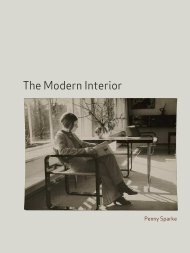Landscape Architecture: Landscape Architecture: - School of ...
Landscape Architecture: Landscape Architecture: - School of ...
Landscape Architecture: Landscape Architecture: - School of ...
- No tags were found...
You also want an ePaper? Increase the reach of your titles
YUMPU automatically turns print PDFs into web optimized ePapers that Google loves.
Giovanni Bellini, The Madonna <strong>of</strong> the Meadow, c 1500<br />
<strong>Architecture</strong> and landscape are ‘the constant presence’ in this typical example <strong>of</strong> the Renaissance figure in ‘ground’. The<br />
ground is, however, highly detailed, with minor but ominous traces <strong>of</strong> discordant potential, such as the trees distorted by<br />
the wind, and nearby a watching black rook. The buildings in the rear ground are medieval and defensive rather than<br />
agrarian or even domestic, as one might expect. The innocence and humanity <strong>of</strong> the key figures is nonetheless reassuring.<br />
painters’ interest in architecture seems to be related with the<br />
process <strong>of</strong> the differentiation <strong>of</strong> the world and individual<br />
consciousness, the birth <strong>of</strong> the first personal pronoun ‘I’. The<br />
smallest <strong>of</strong> details suffices to create the experience <strong>of</strong><br />
architectural space: a framed opening or the mere edge <strong>of</strong> a<br />
wall provides an architectural setting. The innocence and<br />
humanity <strong>of</strong> this painterly architecture, the similarity <strong>of</strong> the<br />
human and the architectural figure, is most comforting,<br />
touching and inspiring – this is a truly therapeutic<br />
architecture. The best lessons in domesticity and the essence<br />
<strong>of</strong> home are 17th-century Dutch paintings. In these paintings,<br />
buildings are presented almost as human figures – the<br />
mirrored images <strong>of</strong> the house and the human body were<br />
introduced into modern thought by the psychologist and<br />
analyst CG Jung and have been expressed by countless artists.<br />
I cannot think <strong>of</strong> a more inspiring and illuminating lesson in<br />
architecture than that <strong>of</strong>fered by early Renaissance paintings. If<br />
I could ever design a single building with the tenderness <strong>of</strong><br />
Giotto’s, Fra Angelico’s or Piero della Francesca’s houses, I<br />
would feel that I had reached the very purpose <strong>of</strong> my life.<br />
The interactions between Modern art and Modern<br />
architecture are well known and acknowledged, but I have not<br />
yet seen an architecture inspired by JMW Turner, Claude<br />
Monet, Pierre Bonnard or Marc Rothko, for example. Painting<br />
and other art forms have surveyed dimensions <strong>of</strong> human<br />
emotion and spirit unknown to architects, whose art<br />
conventionally tends to respond to rationalised normality. The<br />
work <strong>of</strong> numerous contemporary artists – Robert Smithson,<br />
Gordon Matta-Clark, Michael Heizer, Donald Judd, Robert Irwin,<br />
Jannis Kounellis, Wolfgang Leib, Ann Hamilton, James Turrell<br />
20



